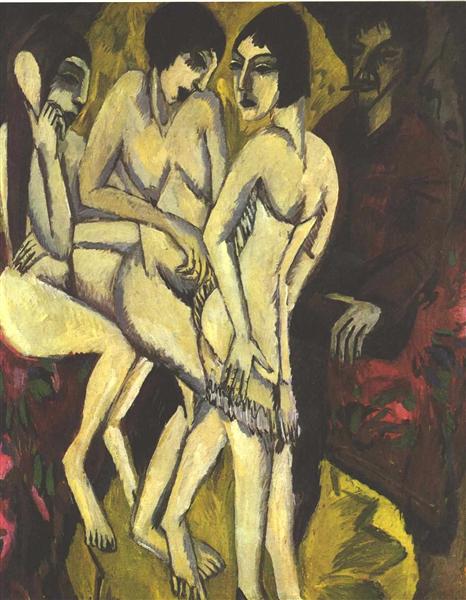Description
The work "The choice of Paris" by Ernst Ludwig Kirchner is presented as a fascinating example of the artistically visceral expression of the expressionist movement. Painted in 1913, this work not only reflects Kirchner's talent as one of the founders of the Die Brücke group, but also raises various interpretations in the context of classical mythological narratives, transformed through modern aesthetic and a bold technique.
He painting It represents an intriguing moment of Greek mythology where Paris, the Trojan Prince, must choose between three goddesses: Hera, Athena and Aphrodite, each promising a gift in exchange for his favor. In "The choice of Paris", Kirchner captures this narrative detached from literalness and reinterprets in a framework that highlights emotional tension through its use of color and composition. The choice is symbolized not only in the physical space, but also in the vibrant palette that Kirchner puts into play. The bright tones of the dresses of the goddesses contrast intensely with a more gloomy and energetic background, which reflects their distinctive style, characterized by strong lines and an expressive brushstroke.
In the work, the female figures are almost in a kind of dance, exhibiting both sensuality and a certain coldness, suggesting the complexity of the choice facing Paris. The scenery is wildly abstract, which moves the viewer away from a purely narrative representation to immerse himself in an emotional and symbolic world. Kirchner, when building a loaded space, seems to push the viewer to consider the act of choice not only as a moment of personal decisions, but as a reflection of the tensions inherent in human existence itself.
A notable aspect of this work is the relationship between the central figures and their surroundings. The forms are blurred in a complex interaction that evokes a sense of continuous movement. This can be interpreted as a comment on the ephemeral nature of the decisions we make and the social pressure that often influences them. Kirchner uses a perspective that, although it seems to plan a three -dimensional space, tends to flatten the scene, emphasizing emotionality over realistic representation.
The use of intense and contrasting colors is, perhaps, one of the most outstanding features of this work. The sensuality of the exposed skin of the goddesses contrasts dramatically with the disturbing shadows of the background, suggesting both vulnerability and the power of seduction inherent in beauty. At the same time, the figures seem almost monumentally distant, which reflects the alienation of the human experiences that Kirchner often alluded to in his works.
In the broader context of expressionist art, "the choice of Paris" can be seen as a work that explores not only individuality and friendship, but also the establishment of new identities in an increasingly fragmented world. This piece is inserted into a tradition of reinterpretation of classic myths, where artists not only challenge the aesthetic norms of their time, but reflect on changing social realities, as well as on intrinsic emotions to human experience.
In the production of Kirchner, this work is aligned with other pieces that address themes of the human figure through the lens of modernism, and the tensions that arise from the interaction between tradition and modernity. A legacy that has resonated throughout the decades, underlining its place not only in the history of German art, but in the canon of global contemporary art. "The choice of Paris" invites us to continue exploring the complexities of the choice, desire and identity, elements that are undoubtedly universal and timeless.
KUADROS ©, a famous paint on your wall.
Hand-made oil painting reproductions, with the quality of professional artists and the distinctive seal of KUADROS ©.
Art reproduction service with satisfaction guarantee. If you are not completely satisfied with the replica of your painting, we refund your money 100%.

